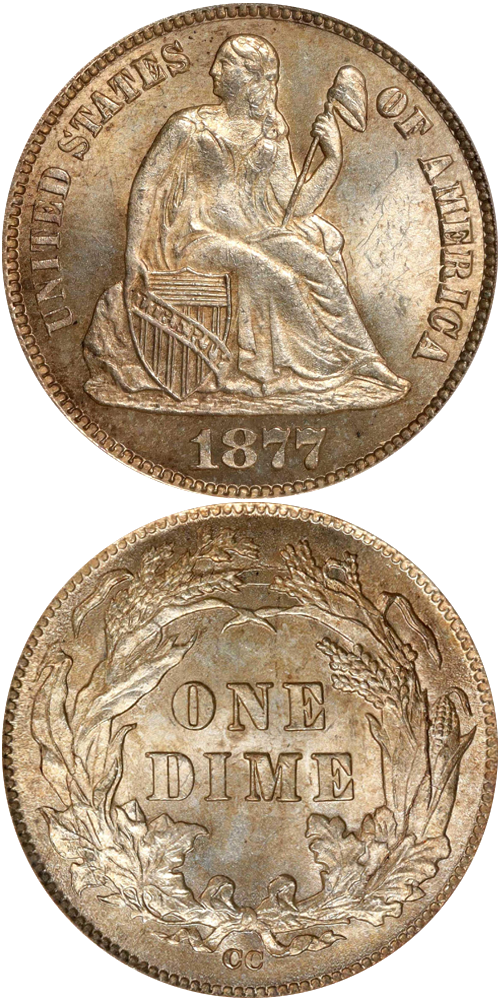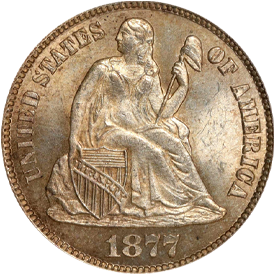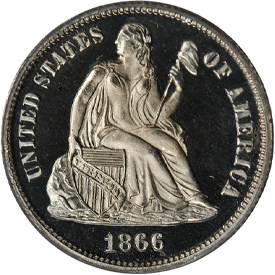Designed by: Christian Gobrecht
Issue Dates: 1860-1873, 1875-1891
Composition: 90% silver, 10% copper
Diameter: 17.9 mm
Weight: 2.49 grams (38.42 grains, 1860 to 1873), 2.5 grams (38.58 grains, 1875-1891)
Edge: Reeded
Business Strike Mintage: 175,889,677
Proof Mintage: 25,403
Like the half dime, the dime underwent a design change in 1860. The Liberty Seated motif was retained on the obverse, but the stars were removed, and in its place UNITED STATES OF AMERICA, formerly on the reverse, was inscribed. The date remained in its regular position below the base of Miss Liberty. The reverse wreath was restyled to a larger format enclosing the denomination expressed as ONE DIME. This style was produced continuously from 1860 through 1891. A number of scarce issues were made during that span, including Carson City pieces of the early 1870s. Dimes of 1873 and 1874 with arrows at the date constitute a separate type.
Dimes of common dates in the 1860-1891 range are readily available in desired grades from Good through AU. Uncirculated pieces are not difficult to find, and superb Uncirculated coins are likewise available. Proofs were struck for collectors and are available for the various Philadelphia Mint issues. Of all Liberty Seated coins in the 1870s through the 1890s-dimes, quarters, half dollars-more dimes by far survive today than do quarters and half dollars.
Further Reading
In 1860 the UNITED STATES OF AMERICA inscription was moved from the reverse of the dime to the obverse, and the reverse wreath was redesigned. Old-style dimes were made at the San Francisco Mint in this year, while Philadelphia and New Orleans issues employed the new motif. This general style was continued through 1891, with a variety being provided by the 1873-1874 issues with arrowheads at the date (this time to signify a slight increase in weight). A number of scarcities and rarities occur during the 1860-1891 span. The 1860-0, the only New Orleans Mint dime until 1891-O, was produced to the extent of just 40,000 pieces and is rare in all grades. A number of years ago a rumor surfaced that only a dozen or so examples of the 1860-O dime were known in all grades. Immediately those possessing such coins, and at least a hundred or so collectors who read the article owned them, started daydreaming about price. Uncirculated 1860-O dimes are indeed rarities, and I recall having handled only two of them during past decades, but worn examples are not difficult to find.
San Francisco issues of the 1860s are rare in Uncirculated grade. A number of these were exported, but unlike their half dime counterparts, they apparently were not candidates for reengraving. Half dimes of the era were sent to the Orient, where in many instances small slivers or shavings of metal were scraped from the Liberty Seated figure in a manner which is not readily detectable except under close examination. Some of these pieces were made into buttons by attaching shanks to them. At the time, Oriental merchants and other citizens prized silver highly, and probably a day spent scraping silver from tiny half dimes would have yielded a fair wage. The Carson City Mint, which first began issuing coins in 1870, produced its first dimes in 1871. Carson City issues from 1871 through 1874 are all very elusive and command high prices whenever offered for sale. Uncirculated specimens are extreme rarities.
The 1873-CC without arrows at date was coined to the extent of 12,400 pieces. What happened to 12,399 of these is a numismatic mystery. Perhaps they were melted. In any event, just one specimen exists today! The piece was acquired by Baltimore collector Louis Eliasberg in the late 1940s and became a keystone in his collection of United States coins, considered to be the most complete ever formed.
From 1875 through 1877 the Carson City Mint produced millions of coins each year, so a collector desiring a dime of this type with a coveted "CC" mintmark can have his needs satisfied by one of these issues. Uncirculated specimens appear on the market with frequency. During the late 1870s and early 1880s the mints were so busy producing large quantities of silver dollars that coinage figures for other denominations – dimes, quarters, half dollars-dwindled sharply. In the dime series the years 1879, 1880, 1881 are all scarce and highly prized today so far as business strikes are concerned.
In the late 1950s, Howard MacIntosh, proprietor of the Tatham Stamp & Coin Company, of Springfield, Massachusetts, sold me a hoard of 1879 Proof and prooflike Uncirculated dimes. At the time these were priced no more than any other date in that range would have been. Each piece was choice and bright, indicating the hoard probably was kept together since the time of issue and may have been part of the Mint leftovers purchased by David Proskey or some other early dealer. A year or so later, Howard MacIntosh telephoned me to offer the entire business inventory of his company for $250,000, stating that it was worth more than a million dollars, but he was hard pressed to come up with funds for a real estate loan and was willing to sell at a sacrifice. I was skeptical that a leading dealer would make such a claim, so I didn't investigate. Subsequently, I learned that he had become despondent and had committed suicide. Eventually his business inventory was sold through the New Netherlands Coin Company and elsewhere and indeed yielded over a million dollars.
In worn condition, Liberty Seated dimes of the 1860-1891 years are available in approximate proportion to the mintages, with issues from the 1863-1869 years being scarcer. Philadelphia Mint coins of 1863 through 1867 are very scarce in all conditions and are great rarities in Uncirculated grade. Uncirculated pieces of the Philadelphia Mint, issues bearing dates from 1882 through 1891, are fairly plentiful in comparison to other Liberty Seated issues of the era. By comparison, other Liberty Seated issues are drastically underpriced throughout the 1860s and 1870s. If detailed knowledge of the availability of various issues in Uncirculated grades is ever published, the situation will undoubtedly be corrected. The type set collector desiring an example of this date range would do well to pick a relatively in expensive piece in the 1880s.








